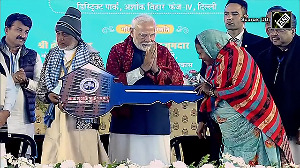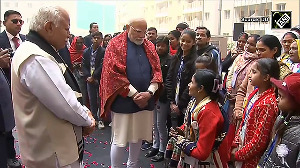
Judging by the latest data on investment flows, foreign investors are increasingly ebullient about India's growth prospects.
Foreign direct investment (FDI) rose to $41.2 billion (about Rs 2.6 lakh crore) during 2014-15 (up to February 2015, the financial year's 11th month), up 31 per cent over the same period the previous year, shows Reserve Bank of India data.
This is the third highest inflow ever in any one year, during the first 11 months.
Other indicators also suggest economic activities are gaining momentum.
The CMIE capex database shows new investment announcements grew in 2014-15 by 80 per cent in value terms, conveying the impression that after a prolonged pause, a revival in the cycle might be on.
The total value of proposed investment was Rs 9.9 lakh crore (Rs 9.9 trillion) in 2014-15, as compared to Rs 5.5 lakh crore (Rs 5.5 trillion) in 2013-14.
This is the highest recorded value of new investment proposals in four years.
The good news is a dramatic surge from the private sector, a 130 per cent increase in proposed investments.
Crucially, infrastructure sector projects rose 118 per cent in value, in new projects.
Although well below the peak of 2008-09, the fact that 'investment intentions', a barometer of investor mood, have risen does point to an improvement in the climate.
It could be construed to mean the first leg of an investment revival is underway.
However, caution economists, only when these intentions translate to action on ground would it firmly signal a revival of the cycle.
What is both puzzling and worrying is the concentration of these announcements in Gujarat, at 40 per cent. Which also suggests the rest of the country has seen a significant slowing of proposals.
This casts a doubt on whether the recovery is indeed broad-based or not.
Govt push
The government on its part has taken a number of steps to push the investment cycle.
According to government sources, from June 2014 to March 2015, the Foreign Investment Promotion Board recommended for approval 163 proposals amounting to FDI of Rs 38,813 crore (Rs 388.13 billion).
The top five sectors which attracted FDI were pharamaceuticals, financial services, information and broadcasting, agriculture and allied activities, and infrastructure and construction.
Further, it has tried to resolve projects that were stalled or abandoned. \
According to official sources, the number of projects revived in 2014-15 rose almost 600 per cent year-on-year.
The total value of these revived projects is estimated to be Rs 1.9 lakh crore (Rs 1.9 trillion) in 2014-15, up from Rs 27,000 crore (Rs 270 billion) in 2013-14.
Infra projects worth Rs 75,900 crore (Rs 759 billion) were revived.
Part of the surge in projects cleared could be attributed to the recent coal block auctions. As a significant proportion of stuck projects were in the coal and power sector, the auctions could have paved the way for commencing these projects.
However…
But, central to revival of the investment cycle is bridging the chasm between intentions and execution.
This is contingent on a number of factors. Prominent among these are a pick-up in domestic demand.
As current capacity utilisation rates remain low due to sluggish demand, it doesn't make sense for corporate groups to launch fresh investments immediately.
However, economists expect urban demand to pick up and compensate for the slack in rural demand.
The other stumbling blocks are a highly leveraged corporate sector and a banking system which is saddled with a huge amount of non-performing assets (NPAs).
The International Monetary Fund's Global Financial Stability Report, 2015, notes a significant share of debt in countries like India is owed by companies with relatively constrained repayment capacity, in terms of interest-coverage ratios.
This impairs their ability to finance fresh investments, making them dependent on bank finance.
The reality is that the banking sector is severely constrained by NPAs.
Thus, credit growth has been fairly muted.
The IMF report also notes that in India, loss-absorbing buffers of banks have deteriorated quite substantially in recent years.
Further, while stock markets remain buoyant, there isn't a healthy list of companies filling for Initial Public Offers of equity; those which have tapped the markets have struggled to get their issues through.
Thus, funding is likely to remain a constraint.
Economists remain guarded in their optimism. While the signs do indicate an incipient recovery, they say, a full-blown, broad-based one will, indeed, be a protracted process.
GROWTH STORY
Foreign direct investment (FDI) rose to $ 41.2 billion during 2014-15 (up to February 2015)
The total value of proposed investment stood at Rs 9.9 lakh crore (Rs 9.9 trillion) in 2014-15, compared to Rs 5.5 lakh crore (Rs 5.5 trillion) in 2013-14
Infrastructure sector projects witnessed an increase of 118 per cent in value of new investment projects
Surge in the private sector, which saw a 130 per cent increase in proposed investments










 © 2025 Rediff.com -
© 2025 Rediff.com -